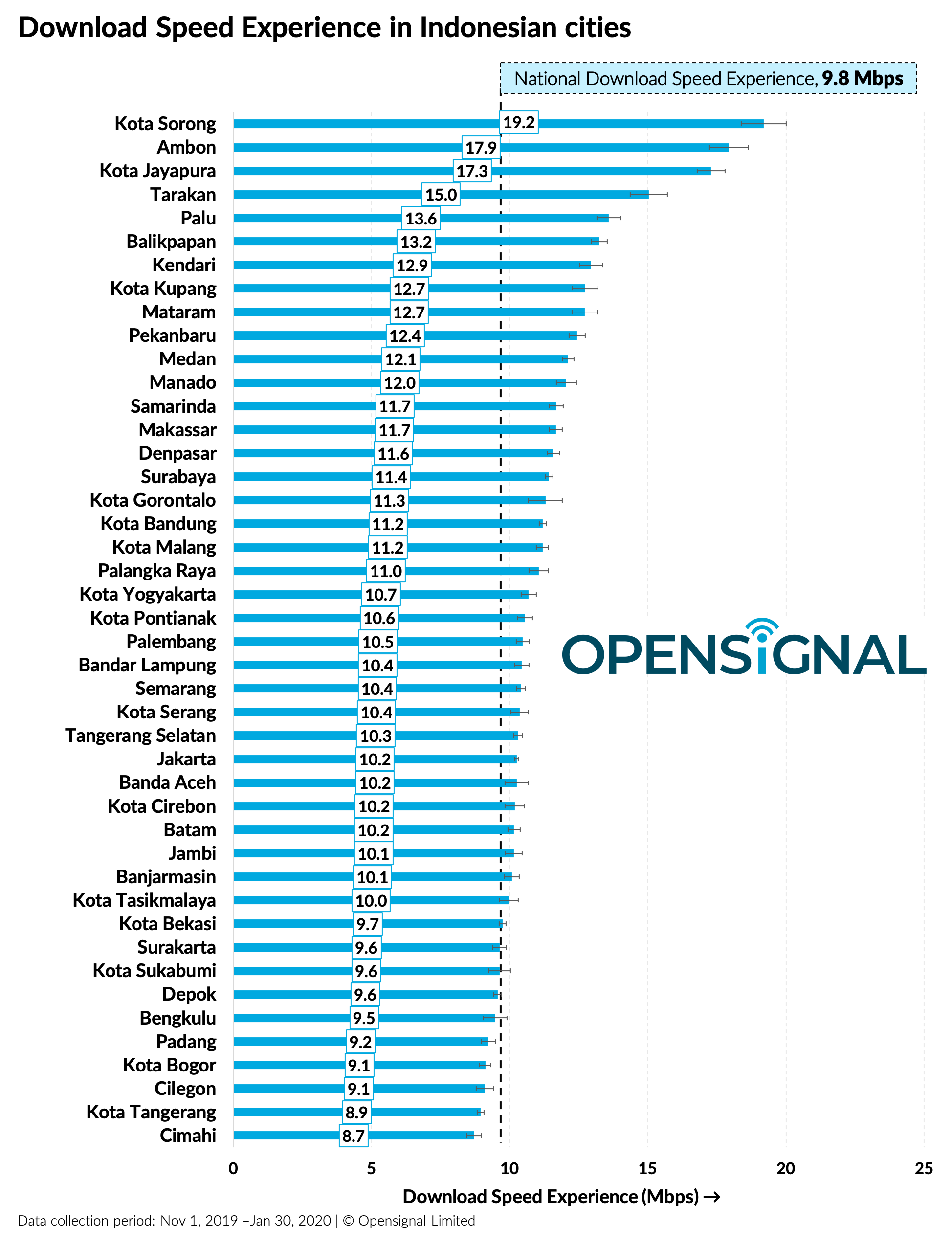Over the last few years, we have observed some impressive improvements in Indonesia's mobile network experience in the uptake of the country's significant investments to transform into the largest digital economy in South-East Asia. With high speed internet connectivity being the cornerstone of a robust digital economy, we take another look at the download and upload speeds observed in Indonesia’s 44 biggest cities to understand the current growth, which should also act as a good yardstick by which to measure future progress.
At the top of our list for Download Speed Experience is West Papua's Kota Sorong and the Maluku Islands' Ambon — both cities are statistically tied for first place, and retained their position in the top three with a massive improvement of around 60% since our previous analysis. While, Jayapura, the capital of Papua comes third with users in the city experiencing the highest boost of 85% among all cities. It was noteworthy that users in all three cities are seeing speeds that are close to double the current national average of 9.8 Mbps.
Kota Kupang, the capital of East Nusa Tenggara took the top spot for Upload Speed Experience, with our users in the city observing an average upload speed of 8.3 Mbps — an improvement of 70% and nearly double the national average of 4.5 Mbps. In contrast with Download Speed Experience, which had a long tail of cities that were statistically tied for last place — West Java’s Cimahi came in last place for Upload Speed Experience with an average speed of 4.0 Mbps, 0.5 Mbps below the national average. The city also tied for last place for Download Speed Experience and was 1.1 Mbps below the national average.

Speaking of Java, Javanese continue to fall behind their provincial counterparts — they are conspicuous by their absence from the top of the charts, with the highest scoring of them not appearing until the 18th slot for Download Speed Experience (Kota Bandung) and the 15th slot for Upload Speed Experience (Kota Malang).
Jakarta languishes in the 28th slot for Download Speed Experience with its citizens seeing an average speed of 10.2 Mbps (up 2.4 Mbps or 31% since our previous analysis) and fares worse for Upload Speed Experience, taking the 32nd slot with an average speed of 4.8 Mbps — up 1.2 Mbps or 33% from our previous analysis but only 0.3 Mbps above the national average. While these increases seem impressive when viewed in percentage terms, they pale in comparison to some of those seen in other cities. For example, Kota Sorong saw its Download Speed Experience increase by a blistering 60% (7.2 Mbps), while Kota Kupang’s Upload Speed Experience has grown by 69% (3.4 Mbps).
Since our previous look at this topic, it appears that substantial progress has been made by Indonesia’s operators in terms of both Download Speed Experience and Upload Speed Experience across all cities. Our users observed download speeds ranging from 19.2 Mbps (Kota Sorong) to 8.7 Mbps (Kota Tangerang and Cimahi), while in our previous report, they ranged between 12 Mbps and 7 Mbps. Similarly, the upload speeds seen by our users in our most recent data vary between 8.3 Mbps and 4.0 Mbps, a big gain over the range of 5.9 Mbps and 3.1 Mps seen in our previous report.
We’ve also seen significant improvements for these measures of the mobile experience at the national level — the average Download Speed Experience observed by our users during the same period as our latest city-level analysis was 9.8 Mbps (up from the previously observed 6.9 Mbps), while that seen for Upload Speed Experience was 4.5 Mbps (up from 3.1 Mbps). Given that it is much easier to provide users with a good mobile experience in urban areas, it is surprising to see that users aren’t seeing download and upload speeds in excess of the national average in ten and six cities, respectively — with speeds up to 10% lower than the national average.
Despite 4G networks being nearly-ubiquitous, this contrast between Indonesia’s national average and city speeds highlights the connectivity gap that exists between sparsely populated rural areas and densely populated cities, and the challenges faced by mobile operators to provide uniform mobile network experience across the country's vast archipelagic geography. To cope with this digital divide, an obstruction towards Indonesia’s digital economy goals, the Indonesian Govt. recently completed the Palapa Ring — a massive fibre-optic infrastructure project to bring high-speed connectivity across Western to Eastern Indonesia, especially to some of its poorest regions in the country’s east, including the restive region of Papua.
But that doesn't immediately solve the problem for mobile internet users, as they still won't be able to find connectivity on the go for some time to come, especially in Eastern Indonesia where mobile operators have a weak presence. Also, some areas could not be reached by fibre cables, mainly the mountainous areas of Papua and West Papua. Therefore, the Ministry of Communication and Information now plans to install 4000 BTS by end of the year to offer a “truly 4G” signal, and on top of this, they will also deploy Multifunctional Satellite (SMF) to increase access in all regions.
With 5G expected not to launch in Indonesia any time soon, it will be interesting to see the country’s operators take advantage of the breathing space and the new-found connectivity between Indonesia’s islands to try and make the mobile experience a less variable one across its many cities.
Opensignal Limited retains ownership of this insight including all intellectual property rights, data, content, graphs & analysis. Reports and insights produced by Opensignal Limited may not be quoted, reproduced, distributed, published for any commercial purpose (including use in advertisements or other promotional content) without prior written consent. Journalists are encouraged to quote information included in Opensignal reports and insights provided they include clear source attribution. For more information, contact [email protected].
